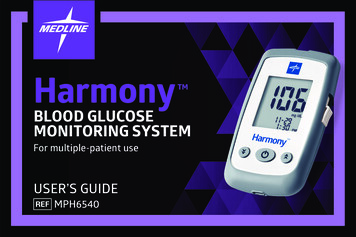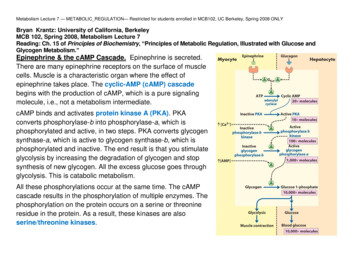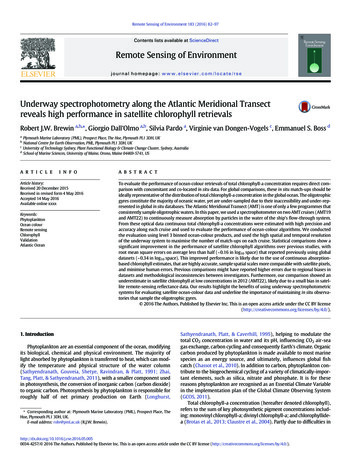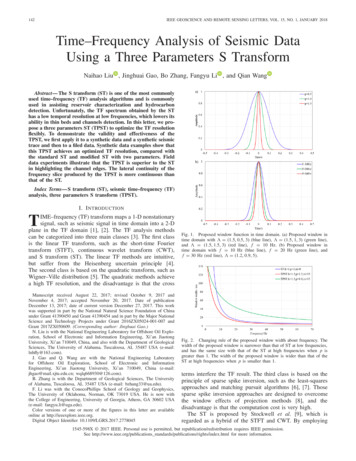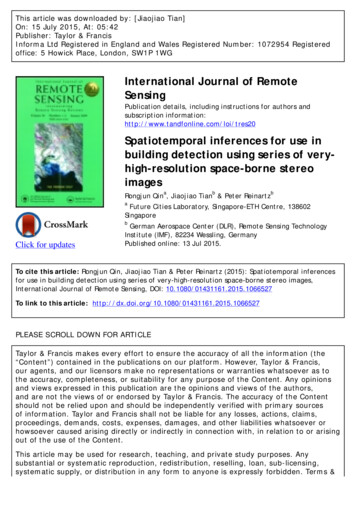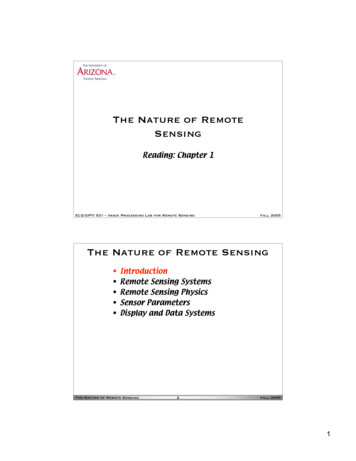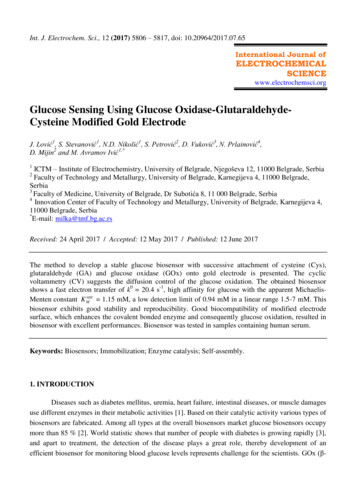
Transcription
Int. J. Electrochem. Sci., 12 (2017) 5806 – 5817, doi: 10.20964/2017.07.65International Journal ose Sensing Using Glucose Oxidase-GlutaraldehydeCysteine Modified Gold ElectrodeJ. Lović1, S. Stevanović1, N.D. Nikolić1, S. Petrović2, D. Vuković3, N. Prlainović4,D. Mijin2 and M. Avramov Ivić1,*1ICTM – Institute of Electrochemistry, University of Belgrade, Njegoševa 12, 11000 Belgrade, SerbiaFaculty of Technology and Metallurgy, University of Belgrade, Karnegijeva 4, 11000 Belgrade,Serbia3Faculty of Medicine, University of Belgrade, Dr Subotića 8, 11 000 Belgrade, Serbia4Innovation Center of Faculty of Technology and Metallurgy, University of Belgrade, Karnegijeva 4,11000 Belgrade, Serbia*E-mail: milka@tmf.bg.ac.rs2Received: 24 April 2017 / Accepted: 12 May 2017 / Published: 12 June 2017The method to develop a stable glucose biosensor with successive attachment of cysteine (Cys),glutaraldehyde (GA) and glucose oxidase (GOx) onto gold electrode is presented. The cyclicvoltammetry (CV) suggests the diffusion control of the glucose oxidation. The obtained biosensorshows a fast electron transfer of k0 20.4 s-1, high affinity for glucose with the apparent MichaelisMenten constant K Mapp 1.15 mM, a low detection limit of 0.94 mM in a linear range 1.5-7 mM. Thisbiosensor exhibits good stability and reproducibility. Good biocompatibility of modified electrodesurface, which enhances the covalent bonded enzyme and consequently glucose oxidation, resulted inbiosensor with excellent performances. Biosensor was tested in samples containing human serum.Keywords: Biosensors; Immobilization; Enzyme catalysis; Self-assembly.1. INTRODUCTIONDiseases such as diabetes mellitus, uremia, heart failure, intestinal diseases, or muscle damagesuse different enzymes in their metabolic activities [1]. Based on their catalytic activity various types ofbiosensors are fabricated. Among all types at the overall biosensors market glucose biosensors occupymore than 85 % [2]. World statistic shows that number of people with diabetes is growing rapidly [3],and apart to treatment, the detection of the disease plays a great role, thereby development of anefficient biosensor for monitoring blood glucose levels represents challenge for the scientists. GOx (β-
Int. J. Electrochem. Sci., Vol. 12, 20175807d-glucose:oxygen 1-oxidoreductase, E.C.1.1.3.4) is the major enzyme used in analytical test kits andbiosensors. It is a flavoprotein which catalyzes oxidation of glucose [4].The first enzyme electrode was reported in 1962 [5]. Since then, tremendous efforts and varietyof approaches have been applied to construct reliable device. Since the GOx redox center is hidden andthe electron transfer is thereby limited, construction of biosensor has been upgraded constantly fromsimple, through the first- and second-, towards third-generation glucose biosensors.There is an increasing interest and need to develop an electrochemical glucose biosensor byimmobilizing enzyme on an electrode surface. Nature of the electrode surface as well asimmobilization technique is very important due to attached enzyme needs to maintain reasonableactivity and, what is most important, high stability. Immobilization techniques include adsorption,encapsulation, entrapment, cross-linking, or covalent binding [6, 7]. However the most commonmethods are adsorption and covalent linking. In the case of adsorption, although the simplest and thefastest, lack of stability is a fatal drawback. On the contrary, the covalent binding provides a stablecomplex between the enzyme and support and overcomes these shortcomings.Gold is frequently used for immobilization of enzymes [8]. The Au surface can be modified byself-assembled monolayers (SAMs), and for more than 20 years SAMs were used as the basis ofelectrochemical sensors [9]. Variations of gold electrode modifications are multifarious and due to itsaffinity toward sulfur, the first modification step usually involve compounds with thiol (-SH) group.These groups chemisorb onto the gold surface forming gold-thiol bond [9] giving a highly ordered anddensely packed monolayer. Comparing to cystamine, mercaptan compounds and other frequently usedreagents, cysteine is cheaper and more stable and it is often recognized as SAMs reagent [10].There are few papers that describe the usage of cysteine, an essential thiol amino acid, in thefirst modification step of gold electrode in preparation of biosensors [10-12]. The introduction ofreactive amino groups of cystein enables a binding layer for forthcoming steps for electrodemodifications.Glutaraldehyde (GA) is a well-known powerful crosslinker with reactive aldehyde groups onboth ends and one of the most widely used reagents for the activation of aminated surface [13]. Oneterminal aldehyde group interacts with the amino group on the solid surface, while the other reactswith the enzyme amino group. GA surface modification is also important from the standpoint of theimmobilized enzyme stability. The increase of the system stability represents a crucial task for theindustrial application. GA activation of the surface may have a positive impact on the stabilizationsince it provides the possibility of the enzyme multipoint covalent attachment. Such phenomena mayincrease the rigidity of the immobilized enzyme and make it less susceptible to conformationalchanges during the biocatalytic processes [14, 15]. Au has been already modified by GA combinedwith Cys for peroxidase immobilization in order to obtain a sensor for dopamine determination [11].Glucose oxidase (GOx) is a first choice as a biosensing model molecule in many studiesbecause it is stable and relatively low cost compound [16, 17]. Also, GOx is used in biofuell cells [18]and in clinical praxis [19-21].In this work, we presented a method for the construction of a stable glucose biosensor bysuccessive attachment of cysteine, glutaraldehyde and glucose oxidase onto gold electrode and testedsuch biosensor for glucose sensing. The electrooxidation ability of glucose was tested by CV. In
Int. J. Electrochem. Sci., Vol. 12, 20175808addition, the stability of modified surface was examined. The dependency of anodic currents vs.glucose concentration was examined for a set of concentrations used for the glucose measurements insamples.2. MATERIALS AND METHODS2.1.1. ChemicalsGlucose oxidase from Aspergillus niger (EC 1.1.3.4), Type VII, 149 800 U g-1 ( 150 U mg-1solid), L-cysteine and D-( )-glucose were purchased from Sigma Aldrich. Glutaraldehyde waspurchased from Acros Organics, and salts for the phosphate buffer from Merck Alkaloid. A MiliporeWaters Milli-Q purification unit was used in order to obtain deionized water.2.1.2. Immobilization procedureThe modification of electrode with cysteine (Au-Cys) was performed as it was describedpreviously [22]. Briefly, previously cleaned electrode (in a way described for preparation of electrodesurfaces) was immersed into 30 mM cysteine aqueous solution at the room temperature (24 h). Thenthe electrode was rinsed using deionized water (to remove cysteine - loosely attached).Secondly, the Au-Cys modified electrode was immersed into 2.5 % solution of glutaraldehydein phosphate buffer (0.1 M pH 8.0) at the room temperature (1 h). It was then washed with the samephosphate buffer. Finally, Au-Cys-GA modified electrode was immersed into 3 mg cm-3 glucoseoxidase solution in phosphate buffer (0.1 M pH 7.0) at 4 C (3 h). The obtained enzyme electrode AuCys-GA-GOx was washed with the same buffer (pH 7.0) and used in further experiments.2.1.3. The preparation of samples containing human serumThe human serum was collected and clinically prepared from ten healthy volunteers and spikedwith glucose as was described previously [23].2.2. Electrochemical experimentThe electrochemical experiment was performed as previously described [23].3. RESULTS AND DISCUSSION3.1. Electrochemical behavior of glucose over the modified electrodesImmobilization of GOx on modified electrode (Au-Cys-GA) was electrochemicallycharacterized by CV in phosphate buffer. It was already published that the lipase from C. rugosa
Int. J. Electrochem. Sci., Vol. 12, 20175809enzyme is most active in pH 7.0 phosphate buffer [24] and it seems that this medium is the best choicefor the electrochemical enzyme studies. The performance of this (Au-Cys-GA) electrode wascompared to Au electrode containing GOx immobilized by absorption and Au electrode (Fig. 1). Thedifference in the CV curves for the investigated electrodes in the region of surface oxidation/reductionoccurs. Voltammogram of Au-Cys-GA-GOx presented in the Fig. 1 shows the small current increasein the area before oxide formation, while in the oxide formation area a significant current increase canbe observed.Figure 1. CVs obtained on gold electrode using phosphate buffer (0.1 M, pH 7.0) (dotted line), AuGOx (dashed line) and Au-Cys-GA-GOx (full line) at scan rate 50 mVs-1.The peak of the oxide reduction also increases in comparison to the oxide reduction of the Auelectrode in phosphate buffer solution. It is obvious that Au covered only with adsorbed GOx exertscurrent decrease in the region of oxide formation and reduction in comparison to Au electrode. Thisindicates the existence of different bonds between the enzyme and Au electrode and the Cys-GA-GOxand Au electrode surface.The adsorption of the GOx molecules on the gold electrode should mainly be governed byhydrophobic interactions, and the hydrophobic regions (colored in orange in Fig. 2) are located in thevicinity of the active site. After the GOx adsorption on the gold electrode, the access of glucosemolecule to enzyme active site was restricted as is presented in Fig. 2. Thus, the main reason for theAu electrode surface modification with cysteine and glutaraldehyde was creating different environmentand allowing covalent interactions of introduced groups with the enzyme amino groups. Those groups
Int. J. Electrochem. Sci., Vol. 12, 20175810are located opposite to active site access and after immobilization approach of glucose molecules iseasier.Figure 2. Distribution of hydrophobic amino acid residues (orange), residues with amino group (darkblue) and catalytic site (red) on the surface of glucose oxidase from Aspergillus niger. The 3Dstructure was obtained using Pymol vs. 0.99 and data obtained from Protein Data Bank (PDB).PDB code for glucose oxidase from Aspergillus niger is 1CF3.Figure 3. CVs obtained on gold electrode using phosphate buffer (0.1 M, pH 7.0) 5 mM glucose (- . ), Au-Cys ( .), Au-Cys-GA (- - . --), Au-GOx (---), Au-Cys-GA-GOx ( ) human serum atscan rate 50 mVs-1.The immobilized GOx on modified electrode as well as the electrodes with or without crosslinking agents were subsequently tested for the oxidation of glucose (Fig. 3). It is clear from Fig. 3 that
Int. J. Electrochem. Sci., Vol. 12, 20175811glucose exhibited high electrooxidation ability especially with the immobilized GOx on modifiedelectrode (full violet line in Fig. 3). In Fig. 1 in the range of the potential from -0.2 V to 0.4 V only thecurrents of gold double layer are observed. In the presence of glucose in the same range of thepotential, as is presented in Fig. 3, the high activity of glucose electrooxidation is apparent.The detailed explanation of the oxidation of glucose presented in Fig. 3 will be discussedseparately for the electrodes with or without cross-linking agents and for the immobilized GOx onmodified electrode.Au-Cys electrode exhibits low activity toward glucose oxidation. The further addition oforganic layers increases its activity by enlarging the peak intensity and by shifting the beginning of theoxidation to more negative potentials. However, the higher current response (approximately 50 %compared to bare gold electrode) in the oxidation of glucose is observed for the covalentlyimmobilized glucose oxidase (Au-Cys-GA-GOx electrode). While trying to understand the origin ofoxidation ability of investigated steps of modified electrode one should take into account that goldsurface is able to catalyze the oxidation of different sugars including glucose [25-27]. Namely, theglucose oxidation is correlated with the AuOH formation on the gold surface since in the potentialrange -0.1 to 0.3 V chemisorption of OH– occurs [28]. This indicates that the Cys-GA-GOx film onAu surface is not compact and that there were some bare regions which remain catalytically active.This finding is in agreement with the investigation of the influence of gold support on the activity ofGOx immobilized on SAM modified electrodes [25]. Also, the obtained result indicates the stronginteraction as a result of covalent bond formation between GOx and cross-linking agents providingbetter activity of Au-Cys-GA-GOx electrode. At high potentials, in which a layer of gold oxide isformed onto the electrode surface, an apparent catalytic effect on glucose oxidation [29] is observed aswell as for Au-Cys-GA-GOx electrode (Fig. 3).The glucose sensing presented with violet line in Fig. 3 is the same and reproducible in thesamples containing human serum. In addition, the surface of modified electrode impersonate moresuitable environment allowing the enzyme to take the optimal conformation for catalytic activityexpression. It was already suggested that covalent coupling of the enzymes could preserve the enzymeactivity, increasing the electron transfer rate in large extent [30].Very often sensors suffer from interference of O2 and H2O2 endogenously coexisting inbiological systems or as an enzymatic reaction products [31]. Under our experimental conditions (Figs.1-3) there is no possibility for O2 and H2O2 reduction because it proceeds at more negative area of thepotential [32-34] and consequently no interferences with molecule of glucose could occur. Thissuggests high selectivity of modified electrode enabling to proper glucose detection in biologicalsystems.Fig. 4a shows the cyclic voltammograms of GOx covalently immobilized on modified goldelectrode, in phosphate buffer (0.1 M) containing 5 mM glucose, at different scan rates. The linearincrease of anodic peak currents with the square root of scan rate between 20 and 140 mV s-1 impliesdiffusion-controlled electron transfer process (Fig. 4b). For such processes difference between peakpotential and half-height peak potential is equal to Ep Ep1/2 47.7/(αn), where α is the chargetransfer coefficient, and n the number of the electrons in the rate determining step [35]. From the valueof slope of logarithm of anodic peak current vs. logarithm of scan rate (0.58), it can be concluded that
Int. J. Electrochem. Sci., Vol. 12, 20175812this is a diffusion-controlled process, since it is very close to the theoretical value (0.5). So thecalculate value of n is 1.68 i.e. n 2 which is in accordance with previously published results [36-38].The electron-transfer coefficient (k0) for the diffusion-controlled process can be calculated by using theLaviron equation [37].Figure 4. CVs obtained at Au-Cys-GA-GOx electrode using phosphate buffer (0.1 M, pH 7.0) and 5mM glucose and human serum at different scan rates (a), the dependence of anodic peakcurrents on square root of scan rate (b), the dependence of anodic peak potentials on logarithmof scan rate (c).The k0 value can be determined, when the E0 value is known, from the intercept of the plot Epvs. log v (Fig. 4c). The E0 value can be obtained from the intercept of the plot Ep vs. v (at v 0) [39].In our system for Au-Cys-GA-GOx electrode, E0 was obtained as 853 mV and the k0 as 20.4 s-1. Theelectron-transfer coefficient for the glucose oxidation on electrode containing GOx immobilized byadsorption on Au was calculated to be 1.02 s-1. The small value of k0 indicates the slowelectrochemical process, signifying the importance of cross-linking agents and their influence in betteractivity for glucose oxidation. The structure of modified electrode surface provides strong interactiondue to the formation of covalent bond and more suitable environment for GOx by taking the optimalorientation contributing its catalytic activity toward glucose.The obtained value for k0 toward glucose with GOx immobilized on Au-Cys-GA is higher thanthe value obtained on cobalt hydroxide nanoparticles electrodeposited on the surface of glassy carbonelectrode [36] and on graphene oxide modified pencil graphite electrode [39].Further analysis of the voltammograms is based on linear relationship Ip vs. v0.5 enabling thedetermination of diffusion coefficient (D), by using the Randles-Sevcik equation (1) [31]:
Int. J. Electrochem. Sci., Vol. 12, 2017I p 2.99 105 0.5n1.5 AC D0.5v 0.55813(1)where Ip is the peak current, A is the electrode surface area, D is the diffusion coefficient, andC* is the bulk concentration of glucose. The obtained value of the diffusion coefficient for glucose inthis work (2.1 10-7 cm2 s-1) is higher than the one obtained with GC/NiOOH [40], but smaller thanthose obtained with GC/MWCNT/NiOOH electrode [40] and cobalt hydroxide nanoparticleselectrodeposited on the surface of glassy carbon electrode [36].Figure 5. Currents values collected at 170 mV of the Au-Cys-GA-GOx electrode in the presence ofvarious concentrations of glucose in the phosphate buffer solution (pH 7.0). Inset: TheLineweaver-Burk plot.The dependency of anodic currents of glucose oxidation electrode on different glucoseconcentrations shows a trend typical for Michaelis-Menten kinetic as is presented in Fig. 5 (the dataobtained from results already given in [41]). In inset of Fig. 5, the plot of oxidation currents vs. glucoseconcentration at a potential of 170 mV is displayed. There is a linear relationship between current vs.glucose concentration in the range from 1.5 to 7 mM. Detection limit was found to be 0.94 mM whilethe signal to noise ratio was 3. The sensitivity value, obtained from the slope of the plot, was 2.65 μAmM 1 cm-2.The apparent Michaelis-Menten constant [42] is obtained by using the Lineweaver-Burkequation [43]:
Int. J. Electrochem. Sci., Vol. 12, 2017581411 I max K Mapp II max c(2)were I is the steady-state current observed after the addition of glucose, Imax is the maximumcurrent measured under saturated glucose conditions and c is the glucose concentration.The K Mapp value (1.15 mM) was calculated from the slope and intercept of the equation 2 (Fig.5). The additional comparison of analytical parameters of some reported biosensor containing goldwith the presented results is shown in Table 1. The investigated Au-Cys-GA-GOx electrode exhibitedcomparable sensitivity to [44, 45] while the apparent Michaelis-Menten constant is lower regardless to[42, 45-47].Table 1. Analytical parameters of glucose biosensors on gold electrode modified with different ntenconstant(mM)Linearrange(mM)Accuracy R.S.D (%)ReferenceAu-Cys-GA-GOx2.651.151.5-72.5 (n 8)present workTEOS/AuNPs/GOx/C2.43/0.5-550.5 (n 8)[44]Chitosan-gold NP/3.50.051.33.3 (n 5.351-105[48]The increased affinity of the GOx towards glucose after immobilization indicates changes inthe enzyme conformation that enables the access of the glucose molecule to the enzyme active center.GOx redox center contains three amino acid residues (His 516, Glu 412 hydrogen bonded to His 559)[49] buried inside the enzyme structure (colored red in the Fig. 6a). As it can be seen in the Fig. 6b themajority of the enzyme amino groups are located opposite to the active center (dark blue regions).Therefore, the covalent bond enzyme is fixed in the conformation that the active center is positioned tothe solution. Also, formed covalent bonds can partially unfold secondary structure and enable moreefficient electron transfer by revealing the entrance of the active center. This is in accordance with theobtained voltammetric results presented in Figs. 3 and 5, promoting the Au-Cys-GA-GOx surface
Int. J. Electrochem. Sci., Vol. 12, 20175815suitable for the further biosensor development. Physical insight in the surface morphology andmicrostructure of layers of glucose biosensor was performed by Fourier transformed infra redspectroscopy (FTIR), atomic force microscopy (AFM) and optical microscopy (OM) and alreadypresented in [41].Figure 6. Distribution of amino acid residues with amino group (dark blue) and catalytic site (red) onthe surface of glucose oxidase from Aspergillus niger (a) Front view on catalytic site. (b) 180orotation of the front view in x–y plane. The 3D structure was obtained using Pymol vs. 0.99 anddata obtained from Protein Data Bank (PDB). PDB code for glucose oxidase from Aspergillusniger is 1CF3.3.3. Selectivity and reproducibility of the Au-Cys-GA-GOxThe stability of the Au-Cys-GA-GOx biosensor was investigated after 7 days by storing it at 4C. CV technique was used and after 7 days 95% of electrode initial current response was retained. This high stability of Au-Cys-GA-GOx isdue to the chemical stability of Au-Cys-GA modified electrode and the covalent bond between GOxand Au-Cys-GA.Six Au-Cys-GA-GOx surfaces were prepared separately and tested by cyclic voltammetry. Inthis way, the reproducibility of the system as well as the reliability of preparation procedure waschecked. The relative standard deviation (R.S.D.) value was found to be 5 %. For Au-Cys-GA-GOxelectrode, R.S.D. determined by six successive assays of a 5 mM glucose sample was 2.5 %. The goodproperties of the Au-Cys-GA-GOx biosensor are the result of the natural features of Au-Cys-GA andthe covalent bond with GOx. It can be pointed out that the used procedure for the preparation ofimmobilized enzyme is efficient in order to retain the enzyme electrocatalytic activity. In addition, theimmobilization prevents the loss of enzyme from the electrode surface. 4. CONCLUSIONThe electrochemical behavior of glucose oxidase-glutaraldehyde-cysteine modified goldelectrode toward glucose oxidation was studied and high activity and affinity for glucose wasdemonstrated. The obtained results show that Cys-GA can afford a beneficial microenvironment for
Int. J. Electrochem. Sci., Vol. 12, 20175816the GOx and promote the glucose oxidation. The important advantage of the investigated systemenables proper glucose detection in biological systems because of the lack of interferences with O 2 orH2O2. The glucose oxidase-glutaraldehyde-cysteine modified gold electrode as a biosensor exhibitsexcellent sensitivity, selectivity and stability for glucose monitoring. The Au-Cys-GA-GOx presentedhere may offer an additional approach for developing sensitive and stable system for glucose sensingin samples containing human serum.ACKNOWLEDGEMENTWe are thankful to the Ministry of Education, Science and Technological Development of the Republicof Serbia for the financial support (Grant No. ON172013 and 14.15.16.17.18.19.20.21.22.23.24.I. Dalle-Donne, D. Giustarini, R. Colombo, R. Rossi, A. Milzani, Trends Mol. Med., 9 (2003)169.J. Wang, Chem. Rev., 108 (2008) 814.www.who.int/diabetesY. Horaguchi, S. Saito, K. Kojima, W. Tsugawa, S. Ferri, K. Sode, Electrochim. Acta, 126(2014) 158.L. Clark, C. Lyons, Ann. N Y Acad. Sci., 102(1962) 29.M. Rahman, A. Umar, K. Sawada, Sensor Actuat. B-Chem., 137 (2009) 327.M.C. Tsai, Y.C. Tsai, Sensor Actuat. B- Chem., 141 (2009) 592.J. Gooding, F. Mearns, W. Yang, J. Liu, Electroanal., 15 (2003) 81.A. Ulman, Chem. Rev., 96 (1996) 1533.L. Qingwen, G. Hong, W. Yiming, L. Guoan, M. Jie, Electroanal., 13 (2001) 1342.S.K. Moccelini, S.C. Fernandes, I.C. Vieira, Sensor Actuat. B-Chem., 133 (2008) 364.P. Fu, R. Yuan, Y.Q. Chai, B. Yin, S.R. Cao, S.H. Chen, W.Y. Li, Acta Chim. Sin., 66 (2008)1796.P. Adlercreutz, Chem. Soc. Rev., 42 (2013) 6406.F. López-Gallego, L. Betancor, C. Mateo, A. Hidalgo, N. Alonso-Morales, G. Dellamora-Ortiz,J.M. Guisán, R. Fernández-Lafuente, J. Biotechnol., 119 (2005) 70.T.N. Nwagu, B.N. Okolo, H. Aoyagi, J. Microbiol. Biotechnol., 22 (2012) 628.Z. Yu, Y. Kou, Y. Dai, X. Wang, H. Wei, D. Xia, Electrocatalysis, 6 (2015) 341.R.M. Barros, C.I. Extremina, I.C. Goncalves, B.O. Braga, V.M. Balcao, F.X. Malcata, EnzymeMicro Technol., 7 (2003) 908.K. Servat, S. Tingry, L. Brunel, S. Querelle, M. Cretin, C. Innocent, C. Jolivalt, M. Rolland, J.Appl. Electrochem., 37 (2007) 121.A. Salimi, R.G. Compton, R. Hallaj, Anal. Biochem., 333 (2004) 49.R. Wilson, Biosens. Bioelectron., 7 (1992) 165.A. Noorbakhsh, A. Salimi, E. Sharifi, Electroanal., 20 (2008) 1788.K.J. Dustin, J.M. Tour in H. Wilhelm (Eds.), Nanoscale Assembly: Chemical Techniques,Springer Verlag, Heidelberg, 2005, p. 84.K.M. Drljević-Djurić, V.D. Jović, U C Lačnjevac, M.L. Avramov Ivić, S.D. Petrović, D.Z.Mijin, S.B. Djordjević, Electrochim. Acta, 56 (2010) 47.N.Z. Prlainović, D.I. Bezbradica, Z.D. Knežević-Jugović, S.I. Stevanović, M.L. Avramov Ivić,P.S. Uskoković, D.Z. Mijin, J. Ind. Eng. Chem., 19 (2013) 279.
Int. J. Electrochem. Sci., Vol. 12, 0.41.42.43.44.45.46.47.48.49.5817T. Vidaković-Koh, I. Ivanov, M. Falk, S. Shleev, T. Ruzgas, K. Sundmacher, Electroanal., 23(2011) 927.C. Ampelli, S. Leonardi, C. Genovese, P. Lanzafame, S. Perathoner, G. Centi, G. Neri, J. Appl.Electrochem., 45 (2015) 943.M.W. Hsiao, R.R. Adžić, E.B. Yeager, J. Electrochem. Soc., 143 (1996) 759.M. Pasta, F. La Mantia, Y. Cui, Electrochim. Acta, 55 (2010) 5561.S. Akella, C. Mitra, Ind. J. Biochem. Biophys., 44 (2007) 82.M.D. Wang, X.X. Liu, Z. Nei, C.Y. Deng, M.L. Guo, S.Z. Yao, Sci. China Chem., 54 (2011)1284.B.B. Blizanac, C.A. Lucas, M.E. Gallagher, M. Arenz, P.N. Ross, N.M. Markovic, J Phys.Chem., 108 (2004) 625.G. Gotti, K. Fajerwerg, D. Evrard, P. Gros, Int. J. Electrochem. Sci., 8 (2013) 12643.R. Miah, T. Ohsaka, Anal. Chem., 78 (2006) 1200.A. Salimi, E. Sharifi, A. Noorbakhsh, S. Soltanian, Biosens. Bioelectron., 22 (2007) 3146.J. Bard, L.R. Faulkner (Eds.), Electrochemical Methods: Fundamentals A and Applications, JohnWiley and Sons, New York, 2001, vol. 6.G. Karim-Nezhad, M Hasanzadeh, L. Saghatforoush, N. Shadjou, S. Earshad, B. Khalilzadeh, J.Braz. Chem. Soc., 20 (2009) 141.E. Laviron, J. Electroanal. Chem., 101(1979) 19.Y. Wu, X. Ji, S. Hu, Bioelectrochemistry, 64 (2004) 91.A.A. Sehat, A.A. Khodadadi, F. Shemirani, Y. Mortazavi, Int. J. Electrochem. Sci., 10 (2014)272.A.C. de Sa, L.L. Paim, N.R. Stradiotto, Int. J. Elechem. Sci., 9 (2014) 7746.J. Lović, S. Stevanović, B. Andjelković, S. Petrović, D. Vuković, N. Prlainović, D. Mijin, M.Avramov Ivić, N.D. Nikolić, submitted.Y. Du, X. Luo, J.J. Xu, H.Y. Chen, Bioelectrochemistry, 70 (2007) 342.R.A. Kamin, G.S. Wilson, Anal. Chem., 52 (1980) 1198.M. Barbadillo, E. Casero , M.D. Petit-Domínguez, L. Vázquez, F. Pariente, E. Lorenzo, Talanta,80 (2009) 797.B.P. Crulhas, J.R. Sempionatto, M.F. Cabral, S. Minko, V.A. Pedrosa, Electroanal., 26 (2014)815.J. Hui, J. Cui, Y. Wang, Y. Zhang,J. Liang, X. Zhang, W. Chen, E.E. Ogabiela, S.B. Adeloju, Y.Wu, J. Electrochem. Soc., 161 (2014) B291.H. du Toit, M. Di Lorenzo, Electrocim. Acta, 138 (2014) 86.D. Wan, S. Yuan, G.L. Li, K.G. Neoh, E.T. Kang, ACS Appl. Mater. Inter., 2 (2010) 3083.V. Leskovac, S. Trivić, G. Wohlfahrt, J. Kandrač, D. Peričin, Int. J. Biochem. Cell Biol., 37(2005) 731. 2017 The Authors. Published by ESG (www.electrochemsci.org). This article is an open accessarticle distributed under the terms and conditions of the Creative Commons Attribution /).
1 ICTM – Institute of Electrochemistry, University of Belgrade, Njegoševa 12, 11000 Belgrade, Serbia . World statistic shows that number of people with diabetes is growing rapidly [3], and apart to treatment, the detection of the
